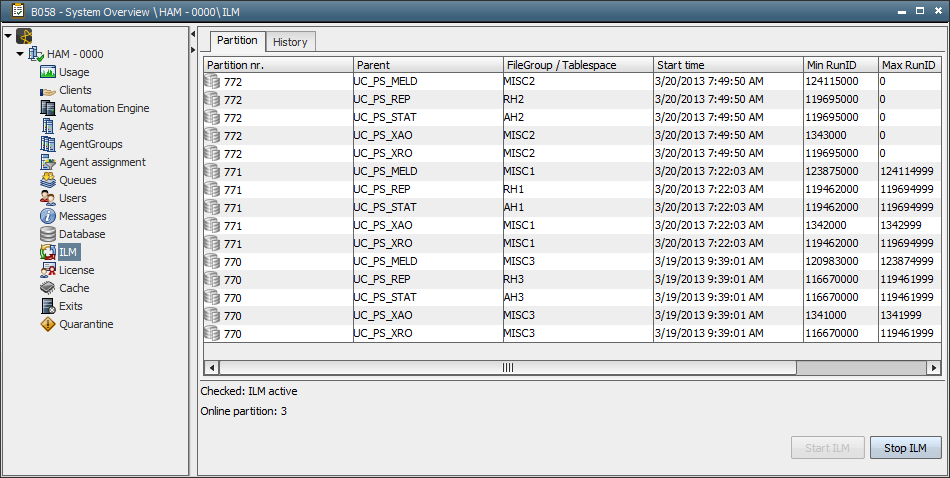
|
License |

System Overview |
Cache |

|
 ILM
ILMThis area lists information about partitions and facilitates checks, switch-outs and deletions.
The System Overview only displays the area ILMStands for Information Lifecycle Management, which refers to a wide-ranging set of strategies for administering storage systems on computing devices. if ILM has been installed and the user privilege "ILM actions" has been granted.
The lower window part indicates whether ILM is active and shows the number of online partitions. You can stop ILM, and in doing so you prevent future partition changes.

The Partition tab contains a list of existing partitions. You can delete staging tables (MS SQL Server) or partitions which are no longer required (Oracle). The History tab displays a list of removed partitions.
All partitions (the current one exempted) can be checked for statistical records of active tasks. The result is a list of these active tasks which can be adjusted manually. On the Partition tab, call up the context menu of the particular partition and select the option Check partition. This checklist includes a further context menu which opens when your right-click a task.
The context menu provides an additional command for MS SQL Server which can be used to trigger a switch-out for a partition without statistical records of active tasks. A switch-out is always made for the oldest partition, regardless of the partition checked in the list.
| Column | Description |
|---|---|
| Partition no. |
Running number of the partition Staging tables (MS SQL Server) always have the partition number "0". |
| Parent | Displays the schema name (MS SQL Server) or the corresponding main table of the AE databaseA database is an organized collection of data including relevant data structures. (Oracle). |
| FileGroup / Tablespace | Name of the FileGroup (MS SQL Server) or the tablespace (Oracle) |
| Start time | Time as of when data records have been stored in the partition. |
| Min RunID | Smallest RunID of the partition |
| Max RunID | Largest RunID of the partition |
| Rowcount | Number of staging-table data records (MS SQL Server) |
| Checked |
Indicates whether the partition could successfully be checked. A check, which is made either before a partition change or manually, is regarded as successful if the partition does not contain statistical records of active tasks. |
The ILM checklist which includes the active tasks of a partition contains the following columns:
| Column | Description |
|---|---|
| Client |
Number of the client in which the task is active |
| Name |
Task's object name |
| Type | Task's object type |
| RunID |
Task's running number (RunID) Tasks whose RunID shows a little red edge include a comment. |
| Status | Task's status symbol and status |
| Start time |
Time at which the task was activated |
| End time | Time at which the task ended |
| User | User who activated the task |
| Parent | Running number (RunID) of the superordinate task that has activated this task |
The following options are available for all tasks in the ILM checklist's context menu:
| Command | Description |
|---|---|
| Details |
Shows the task's Detail Window |
| Report |
Opens the current report for this task Event objects display the report of the event that was last processed (!Process). |
| Statistics Activator | Displays the statistical overview of the activating object. |
| Child-task statistics | Displays the statistical overview of subordinated objects. |
| Comments | Opens a task's comment window. |
| Refresh |
Refreshes the view. |
Additional context menu options are only available for particular tasks:
| Column | Description |
|---|---|
| Partition no. |
Running number of the partition Under MS SQL Server, staging tables always have the partition number "0". |
| Parent | Displays the schema name (MS SQL Server) or the corresponding main table of the AE database (Oracle) |
| Filegroup / Tablespace | Name of the filegroup (MS SQL Server) or the tablespace (Oracle) |
| Start time | Time as of when data records were stored in the partition |
| End time | Time up to when data records have been stored in the partition |
| Min RunID | Smallest RunID of the partition |
| Max RunID | Largest RunID of the partition |